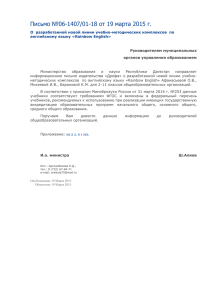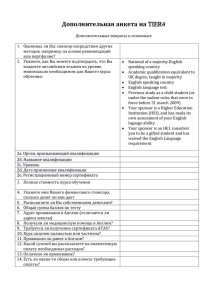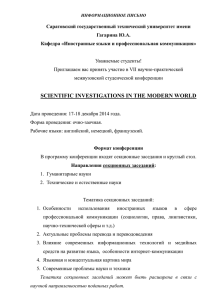Кафедра английской филологии STATE EXAMINATION
advertisement

Кафедра английской филологии STATE EXAMINATION QUESTIONS - 2014 Theoretical Grammar (7) 1. The grammatical category as unity of the grammatical meaning and the grammatical form. Types of oppositions. Types of oppositional reduction: neutralization and transposition. 2. The principles of the division of words into parts of speech. Open and close classes of words. 3. Nominal parts of speech in English. 4. The verb, its general characteristics and categories. Finite and non-finite forms. 5. The sentence and the phrase as basic syntactic units. Traditional classification of phrases Modern classifications of phrases. 6. The simple sentence. Substitution and representation. Cases of transition from simple to composite sentences. Types of syntactic connection (agreement, government, adjoinment, enclosure). 7. The composite sentence as a polypredicative construction. Functional sentence perspective. Linguistic signals of expressing the rheme and the theme. Stylistics (7) 1. 2. 3. 4. Paradigmatic and syntagmatic stylistics. Bilateral classification of stylistic means. The notion of style and sublanguages. Three classes of linguistic units. The notion of norm. Stylistic phonetics. Stylistic morphology. Stylistic semasiology as a branch of stylistics. General classification of figures of replacement. Figures of quantity. Figures of quality. 5. Stylistic semasiology as a branch of stylistics. Figures of co-occurrence. 6. Stylistic lexicology as a branch of stylistics. 7. Stylistic syntax as a branch of stylistics. Theoretical Phonetics (7) 1. Four aspects of speech sounds. Methods of investigation in phonetics and phonology. 2. Segmental and suprasegmental levels in phonetics. Realization of segmental phonemes in speech. Allophones. Distribution. 3. Prosody. The main functions of intonation. Terminal tone. 4. Distinctive and non-distinctive features of English vowels. 5. Distinctive and non-distinctive features of English consonants. 6. Word-stress in English. Its nature, position, and phonological status. 7. Syllable. Articulatory, acoustic, and functional approaches. Lexicology (7) 1. 2. 3. 4. 5. 6. 7. Etymological survey of the English vocabulary. The system of word-building in English. Semantic structure of English words. Polysemy and homonymy. Semantic groupings in the vocabulary. Types of semantic changes and transfers in the development of the vocabulary. English phraseology. English lexicography. 1. 2. 3. 4. 5. 6. 7. 1. 2. 3. 4. 5. 6. 7. История языка (7) Фонетические особенности германских языков. Основные фонетические процессы в общегерманском и древнеанглийском. Основные изменения фонетической системы в среднеанглийском и новоанглийском. Развитие системы существительных от древнеанглийского до наших дней. Развитие системы местоимений и прилагательных от древнеанглийского до наших дней. Развитие личных форм глагола от древнеанглийского до наших дней. Развитие неличных форм глагола и структур вторичной предикации от древнеанглийского до наших дней. Эволюция синтаксических единиц от древнеанглийского до наших дней. History of English (7) Phonetic peculiarities of Germanic languages. The main phonetic processes in Common Germanic and Old English. The main phonetic and graphical changes in Middle English and Early Modern English. Old English noun system and its further development in ME and EMnE. Old English system of pronouns and adjectives and their further development in ME and EMnE. OE finite verbs and their further development in ME and EMnE. Non-finite forms of the verb and constructions of secondary predication in Old English. Their further development in ME and EMnE. Old English syntax, its further development.


